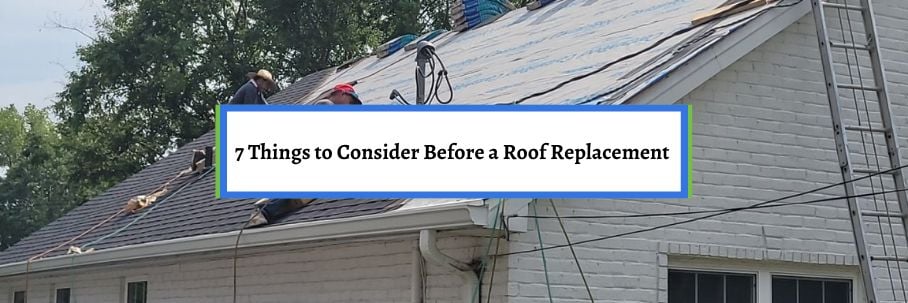7 Things to Consider Before a Roof Replacement

A roof replacement is a huge and expensive home improvement project. Because of this, the last thing you want is to get taken advantage of or make the wrong decisions that put your roof investment at risk.
The great thing is that you can avoid this by simply taking some considerations into account. So, what should you know about a roof replacement before diving headfirst into the process?
For over 30 years, the team at Bill Ragan Roofing has taken pride in being transparent with homeowners. That’s why I’ll break down the 7 things you and every homeowner should consider before a roof replacement.
This article covers the following considerations:
- Make sure you hire a local roofing company
- Get estimates from multiple roofing companies
- Get a full roof replacement instead of nailing over the old roof
- Don’t look for the cheapest roof replacement
- How much you’re willing to spend on a roof replacement
- Your roofing material options
- Carefully review your estimate before signing a contract
1. Make sure you hire a local roofing company
The roofing company you choose impacts every single aspect of your roof replacement, from pricing to final quality. When looking for roofing companies to hire, it’s crucial to only consider ones local to your area.
Any potential roofing company should have a physical office location in your area and a local phone number. This is simply to ensure you can find them for any future problems.
Another reason is to avoid being taken advantage of by a storm-chasing company looking to make a quick buck. These out-of-state companies come in after a big storm, undercut local prices, get the money, and move on to the next storm-hit town.
They don’t care about adhering to local codes or properly installing your roof because they won’t be around to deal with it. On the other hand, a quality local roofing company knows the local installation codes, the paperwork required, and everything else to ensure your roof is correctly installed in compliance with your state’s requirements.
2. Get estimates from multiple roofing companies
Because the roofing company you hire impacts all aspects of your roof replacement, it’s important to find the right one. The best way to do this is by talking to and getting estimates from multiple roofing companies.
This also allows you to compare prices, helps you avoid getting taken advantage of, and find a roofing contractor you trust. However, it’s also important because some roofing companies try to sell you a new roof no matter what.
Let’s say one roofing company is adamant you need a replacement, but two others say you only need repairs. In this scenario, it’s a pretty good bet that it’s not time for a roof replacement.
3. Get a full roof replacement instead of nailing over the old roof
The next thing you need to consider before a roof replacement is to opt for a tear-off reroof (aka roof replacement) instead of nailing over your old one. A nail-over reroof skips the tear-off process and nails a new asphalt roof over the top of your old asphalt roof.
A nail-over is a much cheaper option but has major drawbacks that make it risky.
The main drawbacks include the following:
- You won’t qualify for an enhanced warranty
- Aesthetic issues if you upgrade the type of shingle
- Your current roof flashing has to be used
- It’s harder to repair a roof leak
- You can’t check the condition of your roof decking
- Added cost when replacing the roof in the future
Even if these drawbacks don’t deter you, it doesn’t mean the circumstances are right to nail over your old roof. Your current roof must be near the end of its lifespan, lying down flat, have a few penetrations, a little flashing, and no walls that butt up against the shingles.
It’s your decision to replace your roof or get a nail-over, but a reputable roofing contractor will recommend a full roof replacement 99 times out of 100.
4. Don’t look for the cheapest roof replacement
A roof replacement isn’t a cheap purchase, but it’s crucial not to have the mindset of finding the lowest price and cheapest roofing contractor you can find. Looking for the lowest price makes you a prime target for a bad roofer to take advantage of you.
Once they know you’re looking for the cheapest roof, they’ll lower their prices to outbid other roofing contractors. What they don’t tell you is that they reach these low prices by using cheaper quality materials, cheap labor, or leaving crucial components off your roof completely.
I’m not saying you must buy the most expensive roof, but I guarantee there will be problems if you try to find the cheapest roof possible. If you’re worried about budget, there are ways to afford a quality roof without breaking the bank.
5. How much you’re willing to spend on a roof replacement
After knowing not to look for the cheapest price, the next thing to consider is what you’re willing to spend on your roof replacement. The average roof replacement costs around $12,000-$15,000 for an architectural asphalt shingle roof on a middle-class home.
The roofing contractor you hire and your specific roof greatly impact the pricing, but the type of roofing material you choose also has a huge impact. An asphalt shingle roof is the best choice for homeowners looking for affordability.
The affordability is the main reason architectural asphalt shingles are the most popular type of roofing material in the country. There are also premium roof systems for bigger budgets, but the price difference is significant.
Upgrading to luxury asphalt shingles will be around double the price of an architectural asphalt shingle. Taking it a step further with a standing seam metal roof costs almost triple the price of an architectural asphalt shingle.
Then there are also synthetic shingles, cedar shakes, and slate tiles, but these are premium roof systems most homeowners can’t afford. The important thing is to pick the one that fits your budget and make sure to invest in quality on that specific roof system.
6. Your roofing material options
After determining your budget, you’re ready to choose your roofing material. I briefly mentioned their pricing above, but there are other things you need to know to determine which one is right for you.
The best way to find the right one is by asking yourself these questions:
- What’s my budget for a roof replacement? (You already thought about this)
- How long do I want my roof to last?
- Do I want the best material warranties?
- How important is curb appeal to me?
Think through these questions, and check out how the different types of roofing materials match up. Click on the hyperlinks in the table to learn more about each individual roofing material.
|
Roofing Material |
Cost |
Lifespan |
Material Warranty |
Curb Appeal |
|
$ |
22-25 years |
30-year (prorated after 10) warranty |
Lowest |
|
|
$$ |
25-30 years |
30-year prorated warranty |
High |
|
|
$$$ |
30-50 years |
30-year Kynar 500 paint warranty |
High |
|
|
$$$ |
40-50 years |
Limited Lifetime |
Very High |
|
|
$$$$ |
30 years |
None |
Very High |
|
|
$$$$ |
100+ years |
None |
Very High |
Other than picking your roofing contractor, choosing the right roofing material is the biggest decision you’ll make for your roof replacement. That’s why you need to be sure you make the right choice for you and your situation.
7. Carefully review your estimate before signing a contract
This should be obvious, but it’s crucial to carefully review your estimate(s) and the line items before signing anything. If it impacts the cost of your new roof, it should be included as a line item in the estimate, from the roofing materials to dump fees to the roofing contractor’s labor and much more.
Below are the things that should be included in every roof estimate:
- The number of layers to be torn off
- How your property will be protected
- Installation method
- How they’ll handle replacement decking
- Drip edge
- Your roof system’s components
- The roofing material you choose
- The roof vents
- Replacing pipe boots and flashing
- Dump fees and clean up
- Warranty info
- How long the estimate is good for
- Your right to recession
You shouldn’t just check to ensure the line items are included; you also need to compare them on the multiple estimates you get. This helps you understand why different roofing companies charge a lower or higher price.
For example, there should be a line item for tarps to protect your landscaping, pool, or other areas during the roof replacement. If one company has this as a line item and another doesn’t, you’ll need to consider if the cheaper price is worth potential property damage.
This is just one example, but it shows how doing things the right way can cost more. While the line items are crucial, you also need to read the fine print to check for hidden fees or statements that they aren't responsible for damages.
How much does a roof replacement cost?
There you have it, the 7 things to consider before a roof replacement. However, the biggest pain point for homeowners still needs to be addressed.
This is, of course, pricing. I touched on determining your budget, but it’s hard to do this without having cost numbers.
Unfortunately, the roofing industry doesn’t like to put out specific numbers because of the sticker shock it causes. We don’t believe in hiding anything from homeowners about to invest their hard-earned money in a new roof.
That’s why I wrote another article breaking down how much a new roof costs per square foot based on the roofing material you choose.
Check out How Much a New Roof Costs to learn the budget you’ll need for your upcoming roof replacement.


